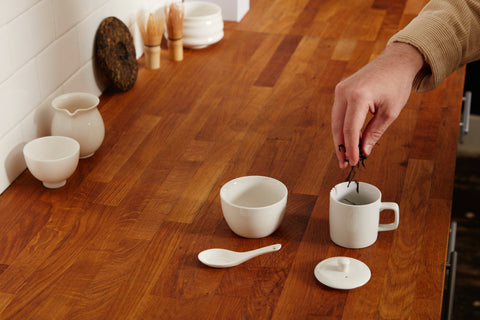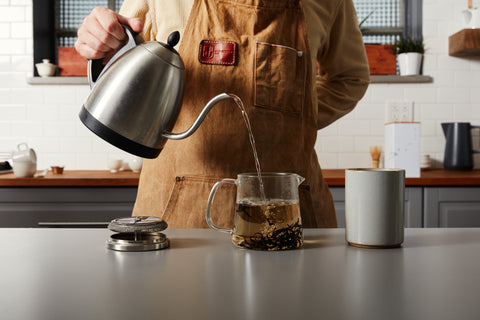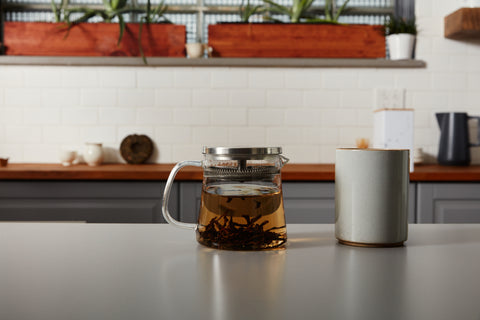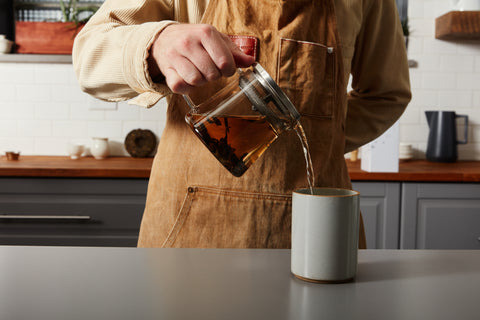Your Cart is Empty
FREE U.S. SHIPPING OVER $50 | INTERNATIONAL OVER $200
Menu
-
- Shop
- Wholesale
- Company
-
Origins
- YUNNAN | Xindi Pu'er Co.
- YUNNAN | Ma Wei Shan Tea Farm
- MEXICO CITY | Arta Cerámica
- GUANGXI | Long Kou Tea Farm
- FUJIAN | Panlan Yancha Farm
- FUJIAN | Zi Ran Hong Smokehouse
- GUANGDONG | Lin Dancong Farm
- ZHEJIANG | Chengtan Longjing Farm
- ZHEJIANG | Yinyu Tea Farm
- JIANGXI | Xiao Qi Chrysanthemum Farm
- NEPAL | Kanchanjangha Estate
- KYOTO | Hori Tea Farm
- KYOTO | Nakai Seichajo
- SHIZUOKA | Mukoujima Tea Cooperative
- NAGASAKI | Sonogi Matcha Farm
- About
- Merch
-
Origins
- Guidance
-
- Login
-
United States (USD $)

FREE U.S. SHIPPING OVER $50 | INTERNATIONAL OVER $200

MODERN (large-format tea steeping)
Modern, or "western" tea making describes tea making that uses less leaves and more water to produce a single serving of tea (usually between 200 - 400 ml, or 8 - 12 ounces). Think of tea making in 1 of 2 "formats"—less leaves and more water, or more leaves and less water. Modern uses the first, with the aim of leaving a complete impression of a given tea through a single, larger steep (as opposed to "traditional", where brief flashes of a tea through several small steepings is the goal).
"Modern" is somewhat of a misnomer; tea making styles new and old are still practiced today. "Western" is, too, since you'll find tea made this way from Houston to Hamburg to Hangzhou. We've opted for Modern to allow room for evolution and editing.
HOW TO MAKE A LARGE-FORMAT CUP OF TEA
EQUIPMENT NEEDED
– Tea (loose leaves or a sachet)
– Teapot
– A way to heat water
– Drinking vessel (cup)
– Scale*
– Variable temperature kettle*
– Filter*
*optional
1 (optional) | Heat water + preheat steeping vessel.
Start by heating water.
Good tea making has an optimal order of operations. Before anything, put the water on (in a kettle or pot on stovetop) so it's ready when time to steep.
Pour some hot water into your steeping vessel to heat it thoroughly—this makes for consistent extraction and good heat retention, so tea steeps evenly and is eventually enjoyed at the right temperature.
Be sure to discard this water before adding tea leaves to vessel!
Hot water poured over leaves in a cold teapot will instantly reduce the water temperature and result in spotty, uneven extraction.
1 | Dose tea leaves.
Add tea leaves to your teapot.
Use a scale if possible. Eye-balling it? Use a pinch, and adjust accordingly. 1 gram per 100 ml of water is a safe bet.
If using a sachet, the recommended dose is almost always 1 sachet.

PRO TIPS
– Always prepare your tea according to instructions on the packaging it came in.
– Handle teas gently; avoid breaking or crushing leaves.
2 | Add water.
Heat water to the best temperature for your tea, and pour water over tea.
The amount of water to use will depend on the type of tea and amount of leaves used. When in doubt, use 100 ml to 1 gram of tea.
Pu'er tea, black tea, darker oolong teas, most white teas, and all tisanes do well with water just off boil (190ºF — 212ºF).
Pan-fired green teas, yellow teas, and light oolongs need cooler water (170ºF — 180ºF).
Steamed green teas and matcha are especially sensitive to heat and need even cooler water (150ºF — 170ºF).

PRO-TIPS
– Use the dry leaf color to determine steeping temp. Light green or yellow? Go cooler. Dark blue, brown, or black leaves? Hotter.
– Steep covered. This increases heat retention and prevents the loss of volatile compounds that contribute to aroma and taste. Fit your teapot with its lid after adding water. If your teapot does not have a lid-strainer, place a simple metal filter over the top (the same you'll use to decant the tea).
– For tender, delicate teas from all categories, pour water around inner walls of your teapot to prevent "cooking" or scorching the leaves. For sturdy, stubborn teas, pour aggressively and agitate with gentle swirls of the teapot.
3 | Time the steep.
Steep tea for a given amount of time per label instructions.
Follow the parameters for steeping time as outlined by your tea provider.
None given? Start with 1 minute to 100 ml of water and adjust accordingly.

PRO TIPS
– Rarely does a cup of tea need steeped longer than 5 minutes. Under-extracted is better than over-extracted, so keep it below this threshold. The exceptions are for re-steepings and tisanes.
– Monitor the extraction and practice recognizing indicators of done-ness.
Liquor color, any aroma you detect, how unfurled the tea leaves become.
4 (optional) | Preheat serving vessel.
Pour hot water into serving / drinking vessel.
Fill the cup you'll drink from with hot water. This brings it to the temperature of your finished tea and prevents a rapid cool-down. A cold mug will rapidly reduce finished tea's temperature.Generally, tea is best enjoyed 10-15º(F) cooler than what it was steeped at, accounting for some inevitable temp reduction during steeping.
Be sure to discard this water before adding finished tea!
PRO TIPS
– Not enough hot water to fill cup? Add just a little and give it a few swirls so it coats the cup's walls for similar effect.
4 | Decant.
Pour finished tea into serving vessel.
When tea is finished steeping, pour into serving/drinking cup through strainer (or over filter) to separate the extraction from the leaves. Using a sachet? Remove it. A tea bag is, fundamentally, a filter.

PRO TIPS
– Fully decant your tea if planning to resteep; any water left in the pot will continue to extract your tea leaves and bungle your next steep.
– If your steeping vessel does not have an in-built strainer, use a simple metal filter placed over your serving vessel to decant.